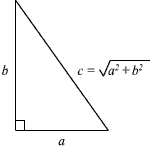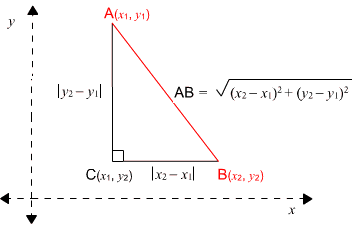|
3.
The distance formula
In the sketch,
how far is the ball from the basket when the netball player in the
free throw releases it? |
|
Using
Synthetic Geometry , we can apply the Theorem of Pythagoras
in triangle ABC:
In
Analytical Geometry, we use an alternate approach:
We use a coordinate system to work out
the distance between the two points.
Distance in one dimension
Firstly,
we need to clarify what “distance” means in a one-dimensional
system (i.e. on a number line).
|
The distance
between two points in a one-dimensional coordinate
system is defined as the absolute value of
the difference between their coordinates.
For
example, on this number line:

Distance
between -1 and 3 is 
Distance between 3 and -1 is 
|
|
Distance
in two dimensions
The
diagram below shows how we introduce co-ordinates, use the definition
of distance in one dimension and apply the theorem of Pythagorus to deduce a
formula for the distance between two points in two dimensions:
Synthetic
Geometry |
Coordinate
Geometry |
 |
 |
Think about the following:
- What happened to
the absolute signs in the formula? Should the formula not be

  and
and  in other words the
order does not matter.
in other words the
order does not matter.- It is often useful
to work with the square of the distance to avoid surds, e.g. AB2
= 13 instead of

Let’s now solve the netball problem using Coordinate Geometry.
As in all problems, our first task is to decide where to place the origin
of the coordinate system. We show below two positions and the corresponding
mathematics. Which one do you prefer and why?
| The coordinates
are A(0, 0) and B(5, 1): |
The coordinates
are A(0, 2) and B(5, 3): |
Triangle ABC has vertices A(3, -2), B(2, 4) and C(9,
-1).
Prove that the triangle is isosceles.
|
|
|